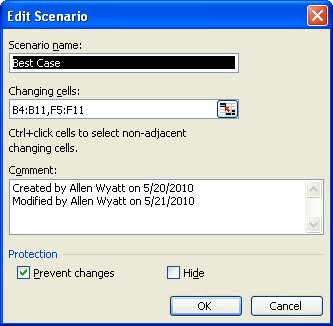Please Note: This article is written for users of the following Microsoft Excel versions: 97, 2000, 2002, and 2003. If you are using a later version (Excel 2007 or later), this tip may not work for you. For a version of this tip written specifically for later versions of Excel, click here: Editing a Scenario.
Written by Allen Wyatt (last updated April 18, 2020)
This tip applies to Excel 97, 2000, 2002, and 2003
Once a scenario is saved, you can later edit it without the necessity of editing the worksheet and resaving the scenario. Instead, you use the Scenario Manager to do the editing. Follow these steps:

Figure 1. The Edit Scenario dialog box.

Figure 2. The Scenario Values dialog box.
ExcelTips is your source for cost-effective Microsoft Excel training. This tip (2862) applies to Microsoft Excel 97, 2000, 2002, and 2003. You can find a version of this tip for the ribbon interface of Excel (Excel 2007 and later) here: Editing a Scenario.

Dive Deep into Macros! Make Excel do things you thought were impossible, discover techniques you won't find anywhere else, and create powerful automated reports. Bill Jelen and Tracy Syrstad help you instantly visualize information to make it actionable. You’ll find step-by-step instructions, real-world case studies, and 50 workbooks packed with examples and solutions. Check out Microsoft Excel 2019 VBA and Macros today!
Excel allows you to create different scenarios for the data in your worksheet. These can be saved and managed using the ...
Discover MoreWhen you create and save scenarios in a workbook, you can later pull them out and display them. Here's how to do it.
Discover MoreIf you've defined a variety of scenarios for your workbook, Excel can provide a handy way to compare the effects of those ...
Discover MoreFREE SERVICE: Get tips like this every week in ExcelTips, a free productivity newsletter. Enter your address and click "Subscribe."
There are currently no comments for this tip. (Be the first to leave your comment—just use the simple form above!)
Got a version of Excel that uses the menu interface (Excel 97, Excel 2000, Excel 2002, or Excel 2003)? This site is for you! If you use a later version of Excel, visit our ExcelTips site focusing on the ribbon interface.
FREE SERVICE: Get tips like this every week in ExcelTips, a free productivity newsletter. Enter your address and click "Subscribe."
Copyright © 2025 Sharon Parq Associates, Inc.
Comments